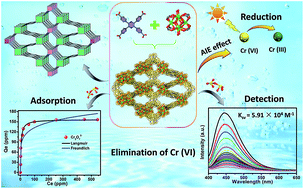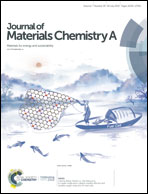A multifunctional Zr(iv)-based metal–organic framework for highly efficient elimination of Cr(vi) from the aqueous phase†
Abstract
A highly stable luminescent Zr(IV)-MOF, [Zr6O4(OH)8(H2O)4(TCPP)4]·9DMF·3.5H2O (JLU-MOF60, H4TCPP = 2,3,5,6-tetrakis(4-carboxyphenyl)pyrazine, DMF = N,N-dimethylformamide) was successfully prepared. JLU-MOF60 with the AIE effect and high porosity consists of 8-c Zr6 clusters and 4-c ligands with an sqc topology. Interestingly, it exhibits remarkable chemical stability in water over extensive pH values varying from 0 to 11. Due to its outstanding water stability and Zr-bonded hydroxides in the framework, JLU-MOF60 shows a high capture capability (149 mg g−1) and rapid adsorption rate (38 mg g−1 min−1) for Cr2O72− in water. Moreover, benefiting from the AIE effect of the H4TCPP ligand, JLU-MOF60 can not only sensitively and selectively detect Cr2O72−, but also effectively photo-reduce Cr(VI) to Cr(III) in the aqueous phase. It is worth mentioning that the KSV value of JLU-MOF60 for detecting Cr2O72− is as high as 5.91 × 104 M−1, and the detection limit is as low as 0.38 μM. Simultaneously, the κ value of the photocatalytic reaction can reach up to 0.058 min−1. Accordingly, JLU-MOF60 can be regarded as a multifunctional material to efficiently eliminate Cr2O72− from the aqueous phase.



 Please wait while we load your content...
Please wait while we load your content...